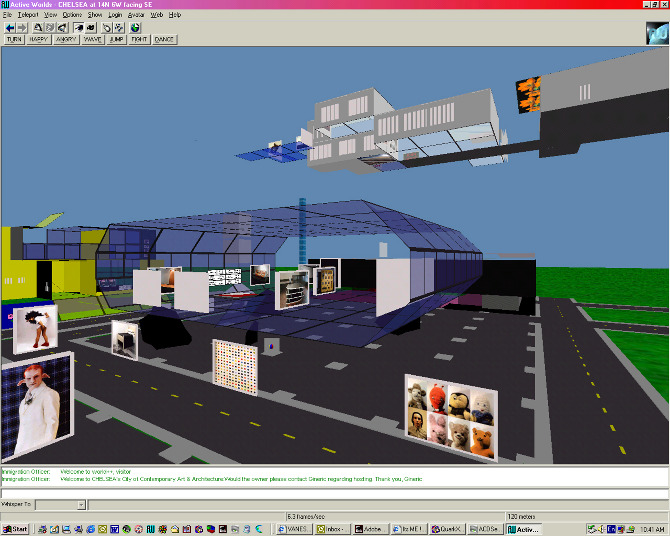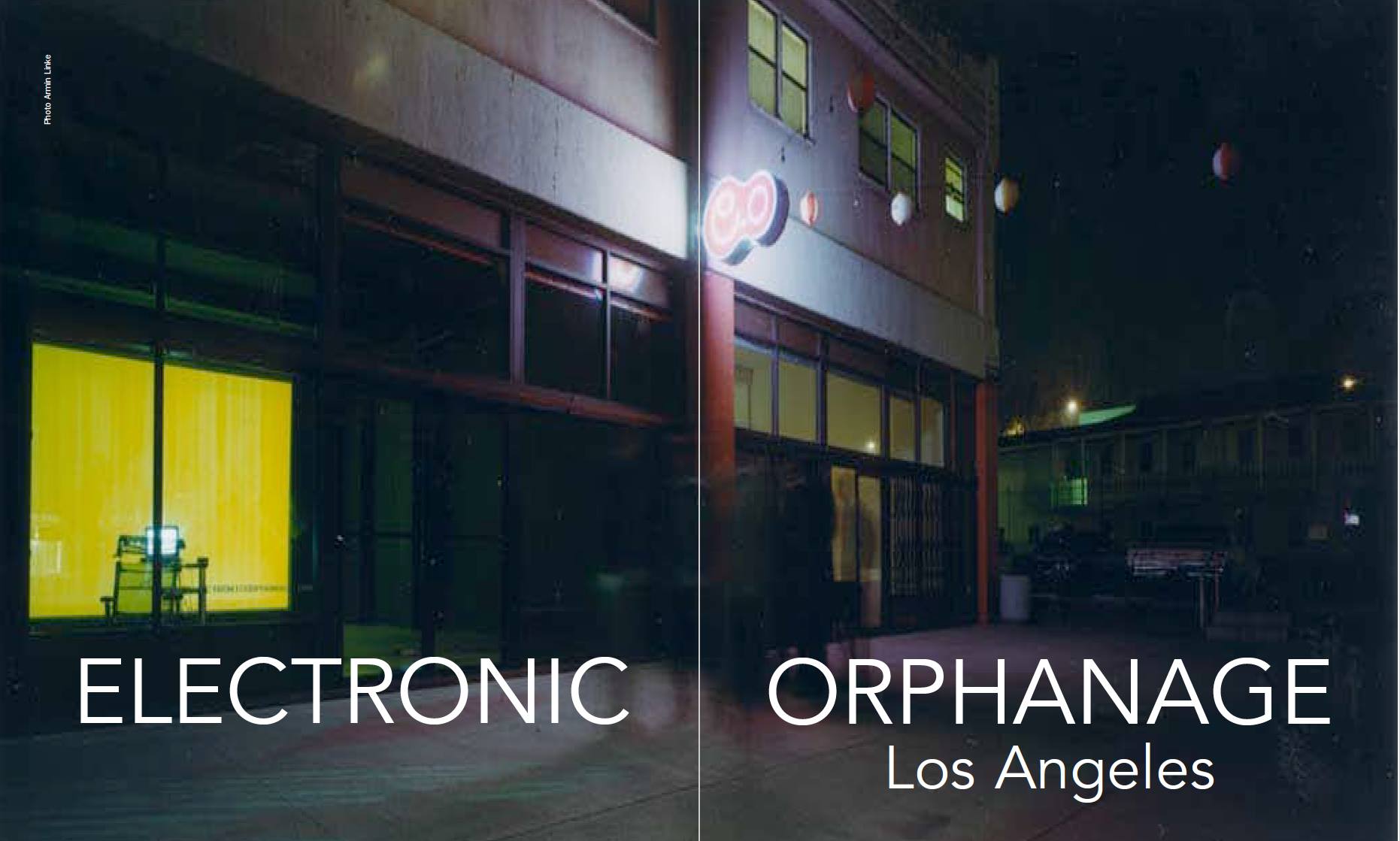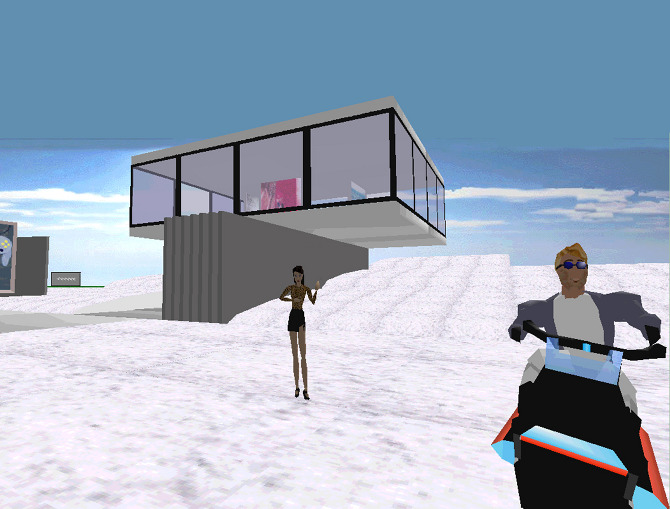This interview accompanies the presentation of Neen as a part of the online exhibition Net Art Anthology, and is part of a series of interviews with Neen participants. Other interviewees are Mai Ueda, Rafaël Rozendaal, and Nikola Tosic. Domenico Quaranta also contributed an essay on Neen in the context of net art.
Lauren Studebaker: Let’s start by talking about things that happened before Neen. I was wondering if you could tell us about the virtual world Chelsea, which was started in 1998. How did you and Miltos Manetas come into collaboration, and how did Chelsea come into being?
AA: Well, what happened was I met Miltos in the summer of ‘94 and then we lost touch for half a year and I went to Columbia to study to do a Masters. That was the first time they introduced the Paperless Studios, sort of computer generator design or computer centered design. So then the next time I met him the summer afterwards, we had both gone onto computers per se. I had this project with buildings communicating with each other, sort of mirroring the idea of a network or a multi-user game but with architecture and then he was into that. So, that's how our friendship grew because we were interested in this new landscape lets say. In ‘97, I was in New York for something and Miltos said, “Look I've seen this active world thing and isn’t it great?”
We started this world. We had a backer who paid for the world. The idea was there would be a world for art and architecture and we would...I was kind of making buildings there and using it almost as a sketchbook so any kind of idea for a building, I would draw it out quickly. Miltos was doing the propaganda or theory behind it. We were giving free studio space to our friends, our artist friends. The idea was that this would be a business. This was ‘98 before the dotcom crash, the internet was meant to be a big business. That is the foundation– along with a couple of other small things– log in and manifest. It become a collection. It was brand new.
We were talking about the 3D web as a landscape of feelings and emotions, not so much about the content, but about making friends. Out of that came this idea, that was centric to me, which back in the time was acting like social media, but before social media.
LS: Right. That project was intended for an “audience with a short attention span”?
AA: Yeah, that is what I kind of find out while building there, making buildings. One, I had to make buildings by copy and pasting nodules—copy/pasting into an object and then it would change into a wall piece or a floor piece or a ceiling piece. I was describing a building, I saw that people got bored easy. So that if I was describing a complicated concept in a chat window, people would just “oh, okay. I will speak to you later.”
So, I would just say this is a pink and blue building or this is a wave building and I would make sure that the shape corresponded to the name. It was kind of saying “viral” but before the notion of “viral” existed. That is what I discovered, that these avatars, which could be a kid, could be a friend of mine, which could be an unknown person had a really short attention span. You were on their computer and they had ten windows, and this was just one of the windows.
LS: Would you say that the experience of the creation of this virtual world informed the development of Neen?
AA: The way to describe Neen is different things for different people. For me, I was into the ideas but Neen gave a name to it. That is what Miltos did. He did a project where we were going to name this new art movement with Art Production Fund in 2000. He selected works that corresponded to the ideas behind the name. Of course when you name an idea, you start recognizing it. We grew as a group or as a network of people. Those ideals from Chelsea were crucial to my work but in a way they still are even though the name doesn't exist. It was for that time when these thing were being discovered. Those ideas were very much about what we developed but of course, with Neen, we developed a particular aesthetic as well.

Andreas Angelidakis & Miltos Manetas, Chelsea, 1998-2001
LS: How are were you introduced to Neen when it came into being 2000? Or maybe you knew about it a little before. How were you introduced to it, and how did you understand it conceptually at first?
AA: I was very close to Miltos and had just done this project so I knew what he was preparing. He even showed my work during the first presentation of Neen as an example of what he was thinking of. I was, in a way, let’s say, part of it from the very beginning. I didn’t need to be introduced to it. It was more like, to come up with things. We would make something... Or Angelo Plessas would make something. We would say this is Neen or this is not Neen. We even had another term, another one of the runner-up names that the branding company, that Miltos hired, came up with, which was Telic. When we would talk about things, we should either this is Neen—this kind of abstract, emotional, meta-social thing. Cute, often, but in the Japanese sense. Also, like viral. I guess those were the key concepts. Telic would be net art or computer art that was about technology. We could appreciate something because it was fascinating, like JODI at the time. But it was not Neen. It was Telic.
LS: What would you say the response was to Neen? What was the reception in the art world? With internet artists? What was going on at the time?
AA: I am guessing it was quite polarizing. The art world didn’t really discover the internet until about three years ago. The art world was considering the internet as a fax machine, something that you send press releases with. I think the art world wouldn’t know what to make of it because it didn’t know what the internet was in 2000. If you look at galleries then, you would never see anything related to the internet. Other art, some people were before us in terms of net art so they would not accept it because it was something different. Other people were interested. Like anything that comes onto a scene, some people like it and some people don’t. Let’s say you are radical or polemic, but for something that is not... When you talk about Neen as describing the “emotional landscape of the internet,” that is harder to be polemic about. In retrospect it was also quite feminine or female in a way.
LS: Was that the same response you got from net artists of the time, or people working with the internet?
AA: Perhaps. I mean people might think it doesn’t seem as serious. So when I would attempt to do Neen architecture, something like the project Cloud house… That was based on ideas of early postmodernism which was critical postmodernism but also can seem as jokey or a fun thing. Especially in net art, you can get this techno-seriousness which Neen was against.
LS: What was Neen’s understanding of how people interacted with computers and the internet and what they wanted from art?
AA: I guess the idea was that the internet and interacting with the world via a screen changes the way you see the real world. Let’s say we are looking for screen qualities in the real world. Would look as they exist on a screen or they would just inhabit the screens directly? A lot of the body of work of Neen, like Angelo Plessas and Rafaël Rozendaal, they were doing these web domain pieces. Almost like poems. Visual poems where the URL was the title of the piece and the contents was an animation. The animation together with the address, the visual with the URL would make the piece.
LS: Right, within the frame of the browser. And most of these websites were designed with Flash. Was Neen generally optimistic about commercial digital products?
AA: Yes, they are based in Flash. It was very much embracing that. The commerciality of that. Even the Japanese cuteness. If you look at something like the Twitter logo, if that existed back then, we would look at that and say “oh, that's Neen.” It is a little bluebird. When you get Twitter used in a political uprising but then their logo is a little cute bluebird, that is interesting.
LS: Did you see the Neen perspective, at this time, contrasting with other artists’ views of the internet and its commercialization at this point?
AA: I don’t want to say that we were a bit self-involved. But, I guess I have to say that. We were really looking at what is Neen rather than comparing to other people. It is not as if we would spend hours looking at every internet art thing. It is more like we looking at what could be Neen, like this poet from Serbia who was making this website called personality stereotypes—Nikola Tosic. It was a series of cliché questions about personalities and then it would get your personality stereotype. That was, in a way, Neen because it was also crass and offensive but also funny and cute and deep in a way. I think a lot of the stuff that later on was dubbed post-internet, maybe Neen could be the archeological version of that. The ancient history of that.
LS: We can talk about some of the other Neen projects. You were a part of Electronic Orphanage, right? What was your involvement and approach to developing that space?
AA: The design that I made was never realized because we didn’t have the funding. When the dot com crash happened and suddenly the internet was not about business anymore, it was not easy to find sponsors. I had made a space that must be hidden there somewhere on the internet, the original design. It was just a screen made up desk modules on tracks so you could pull the screen apart and it would be desks in the space and then push them back and the space would be empty with just screens and cables on the floor. The actual Electronic Orphanage was something that made its rounds.

LS: What was your involvement as it evolved?
AA: I did a show there once, but I wasn’t living in L.A. I wasn’t really an orphan but it was in our group. If we went to L.A., we would hang out there. If I would find something, I would show it to Miltos and maybe he would invite them to the Electronic Orphanage. It was our headquarters, let’s say.
LS: It led to you starting to develop Neen World. Was that commissioned by Electronic Orphanage?
AA: Neen World was actually done for a show at CascO at Utrecht. In the same way as Chelsea, I kind of did Neen World. It was only for our group of people. I would take each artist of Neen, that was involved in Neen, or even people that I knew and I would make a house based on some characteristic of their work. Once, I made a house because this Chinese girl was wearing a pink and red sweater and I like the pattern. So, I made a house from that pattern.
LS: Who were some of the participants? Or the “Neensters” at the time you were developing Neen World?
AA: Mike Calvert, Mai Ueda, Angelo Plessas, Rafaël Rozendaal, Nikola Tosic.
LS: How did you design Neen World to work with your the concept of the online space at the time? How was it used, and how did the participants interact?
AA: For me, it was my sketchbook. I was trying out all these ideas. The basic design premise is that in all these worlds, the first thing you do is design the environment. You pick a sky and a ground much in the way that Microsoft Windows or whatever it was background. Then you put buildings in there. I decided to make Neen World’s background as a real background and then the nature of Neen was the buildings. The buildings were somehow related to nature. Let's say when you arrived you would find yourself in a black forest. Each name of the participants, or Neensters, was carved on one tree.
The tree was a link to their studio or their space. For me, it was very much a design project. A place where, as an architect, I could realize my designs without having a plan or a budget. I could just make something. It was an amazing outlet for that.
LS: Was it a private community?
AA: Yeah. It was a private village. I mean people could use it and visit of course. Sometimes, some people would visit and then eventually become part of it because Neen was a network. People heard about it and then started some affiliation. They might become part of the group.
LS: Is Neen as a word or a concept still useful? Or have its ideas been co-opted by creative software to such an extent that it no longer seems relevant?
AA: Neen was a historical period. Today, it is interesting to look at current ideas and internet art. You could trace them back to Neen but just because it was a zeitgeist. It is not that people knew necessarily about it because it wasn’t that famous or didn’t become popular in contemporary art but you could trace a lot of these idea back to Neen. It was a kind of validation but I can say I am still exploring what it means and what kind of stuff it has done.
Header image: Andreas Angelidakis & Miltos Manetas, Chelsea, 1998-2001


